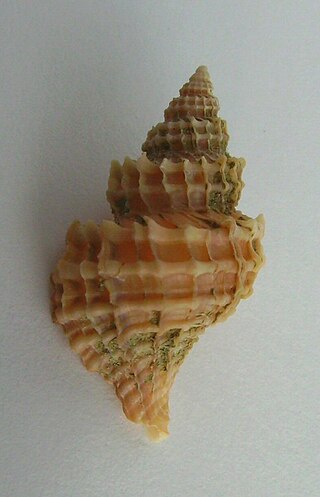
A whorl is a single, complete 360° revolution or turn in the spiral or whorled growth of a mollusc shell. A spiral configuration of the shell is found in numerous gastropods, but it is also found in shelled cephalopods including Nautilus, Spirula and the large extinct subclass of cephalopods known as the ammonites.

The gastropod shell is part of the body of a gastropod or snail, a kind of mollusc. The shell is an exoskeleton, which protects from predators, mechanical damage, and dehydration, but also serves for muscle attachment and calcium storage. Some gastropods appear shell-less (slugs) but may have a remnant within the mantle, or in some cases the shell is reduced such that the body cannot be retracted within it (semi-slug). Some snails also possess an operculum that seals the opening of the shell, known as the aperture, which provides further protection. The study of mollusc shells is known as conchology. The biological study of gastropods, and other molluscs in general, is malacology. Shell morphology terms vary by species group.

Atlantidae is a family of sea snails, holoplanktonic gastropod molluscs in the clade Littorinimorpha.

Carinariidae, known by the common name "heteropods" like their relatives in the Pterotracheoidea, is a taxonomic family of swimming or floating sea snails, pelagic marine gastropod molluscs in the clade Littorinimorpha.

Carinaria is a genus of medium-sized floating sea snails, pelagic gastropod molluscs in the family Carinariidae.

Tonna galea, commonly known as the giant tun, is a species of marine gastropod mollusc in the family Tonnidae. This very large sea snail or tun snail is found in the North Atlantic Ocean as far as the coast of West Africa, in the Mediterranean Sea and the Caribbean Sea. The species was first described by Carl Linnaeus in 1758.

Zeatrophon ambiguus common name the large trophon, is a species of large predatory sea snail, a marine gastropod mollusc in the family Muricidae, the rock snails or murex snails.
William Henry Benson was a civil servant in British India and a pioneer malacologist. He made large collections of molluscs and described over 470 species, mainly from India, Sri Lanka, Burma and South Africa.

The Pterotracheoidea is, according to the Taxonomy of the Gastropoda, a taxonomic superfamily of sea snails or sea slugs, marine gastropod molluscs in the clade Littorinimorpha. They are commonly called heteropods or sea elephants.

Spirotropis aganactica is a species of sea snail, a marine gastropod mollusk in the family Drilliidae.

Nassarius glans, common name the acorn dog whelk, is a species of sea snail, a marine gastropod mollusc in the family Nassariidae, the Nassa mud snails or dog whelks.

Selastele retiarium, common name the netted top shell, is a species of sea snail, a marine gastropod mollusc in the family Calliostomatidae.

Pseudominolia musiva is a species of sea snail, a marine gastropod mollusk in the family Trochidae, the top snails.

Oxygyrus keraudrenii is a species of sea snail, a holoplanktonic marine gastropod mollusk in the family Atlantidae.

Perrinia squamicarinata is a species of sea snail, a marine gastropod mollusc in the family Chilodontaidae.

Carinaria cristata, commonly known as the glassy nautilus, is a species of pelagic marine gastropod mollusc in the family Carinariidae. It is found in the Pacific Ocean and is described as being holoplanktonic, because it spends its entire life as part of the plankton. It was first described by Carl Linnaeus in 1767. Its fragile shell was much prized by early conchologists for their collections, being so rare that it was said to be worth more than its weight in gold.

Nassarius crassiusculus, is a species of sea snail, a marine gastropod mollusc in the family Nassariidae, the Nassa mud snails or dog whelks.

Nassarius subspinosus, common name the prickly dog whelk, is a species of sea snail, a marine gastropod mollusk in the family Nassariidae, the nassa mud snails or dog whelks.

Endothyrella plectostoma is a species of air-breathing land snail, a terrestrial pulmonate gastropod mollusk in the family Plectopylidae.

Raphitoma enginaeformis is a species of sea snail, a marine gastropod mollusk in the family Raphitomidae.

















